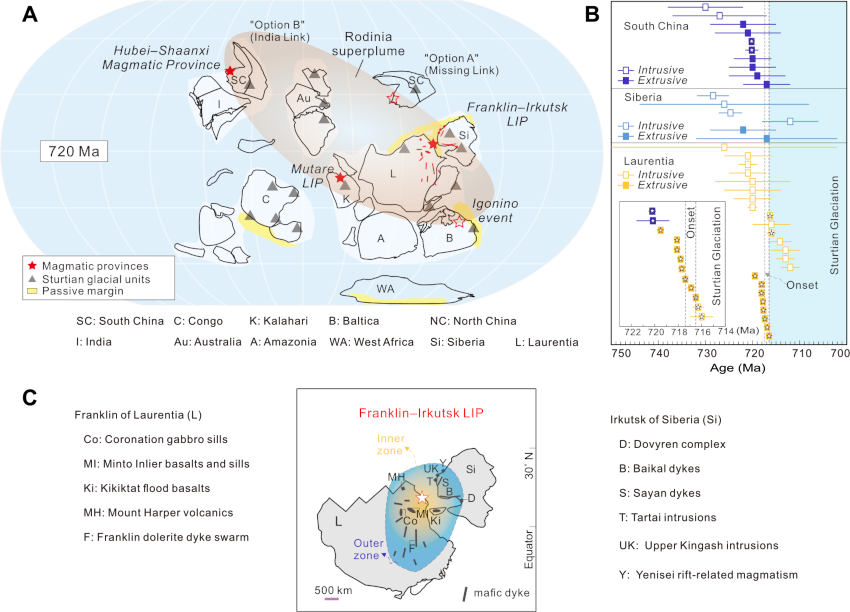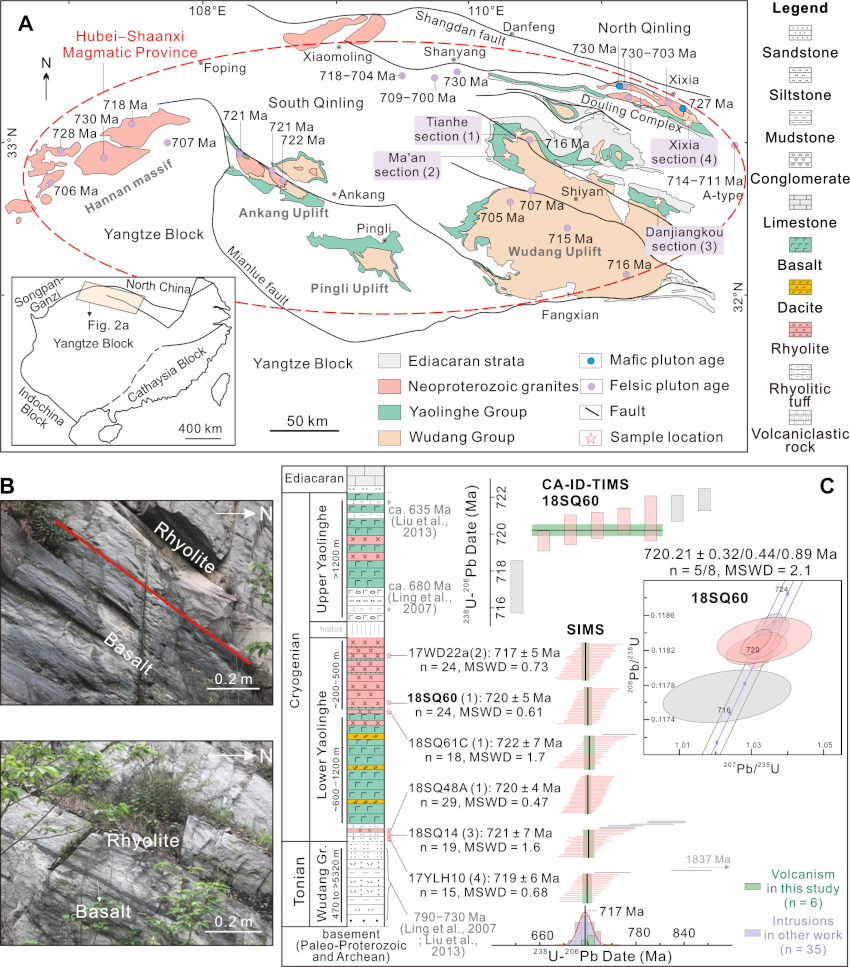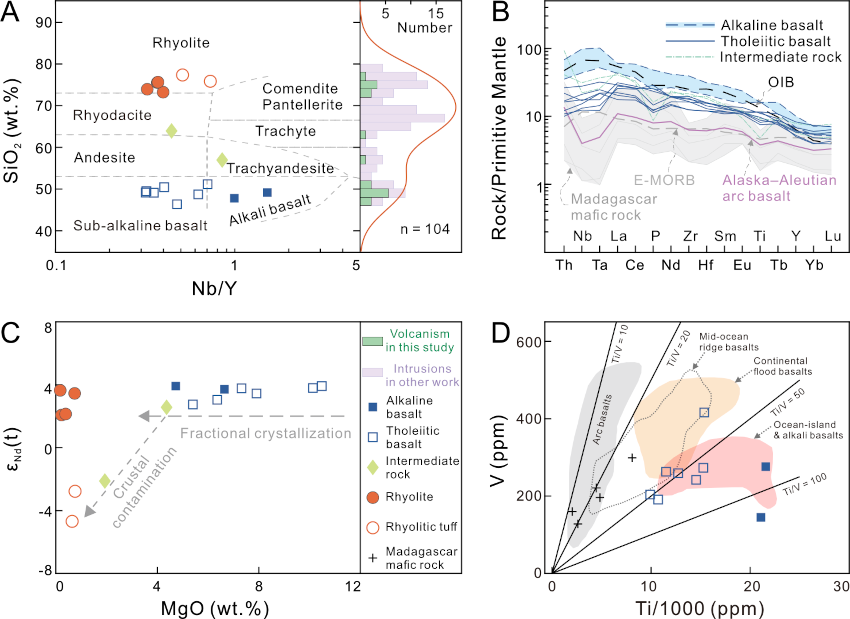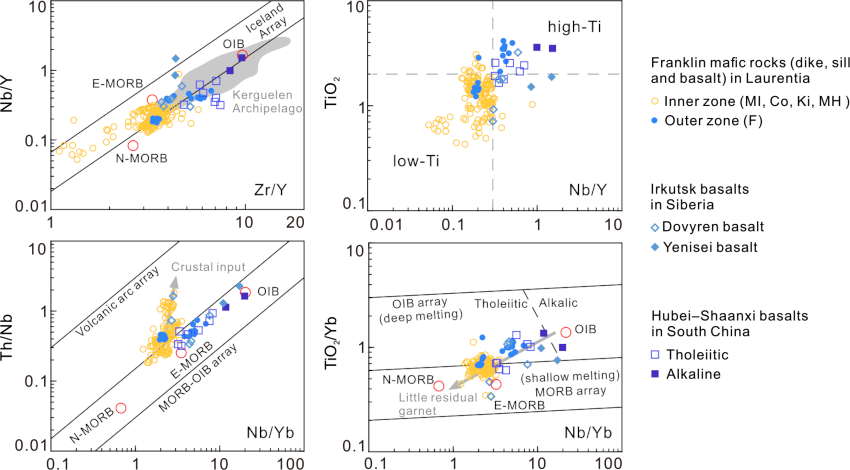September 2022 LIP of the Month
720 Ma magmatic province in South China and the onset of the Sturtian snowball Earth
Kai Lu1,2, Ross N. Mitchell1, Chuan Yang3, Jiulong Zhou1, Liguang Wu1, Xuance Wang4, Xian-Hua Li1,2
1State Key Laboratory of Lithospheric Evolution, Institute of Geology and Geophysics, Chinese Academy of Sciences, Beijing 100029, China.
2College of Earth and Planetary Sciences, University of Chinese Academy of Sciences, Beijing 100049, China
3State Key Laboratory of Palaeobiology and Stratigraphy, Nanjing Institute of Geology and Palaeontology and Centre for Excellence in Life and Palaeoenvironment, Chinese Academy of Sciences, Nanjing 210008, China
4School of Earth Sciences, Yunnan University, Kunming 650500, China
Email: lukai@mail.iggcas.ac.cn; cyang@nigpas.ac.cn; lixh@gig.ac.cn
Extracted and modified from:
Lu, K., Mitchell, R. N., Yang, C., Zhou, J. L., Wu, L. G., Wang, X. C., Li, X. H. (2022). Widespread magmatic provinces at the onset of the Sturtian snowball Earth. Earth and Planetary Science Letters, 594, 117736. https://doi.org/10.1016/j.epsl.2022.117736
Abstract
The temporal overlap between the Franklin large igneous province (LIP) and the Sturtian glaciation onset (ca. 717 Ma) has inspired the hypothesis that either basaltic weathering or stratospheric sulfate aerosol injection of the Franklin LIP plunged Earth into global glaciation. The cool background climate just before the Sturtian has been commonly invoked by such initiation models. Difficulty in definitively linking these concepts with geological evidence has precluded complete demonstration of a snowball trigger mechanism. Here we report that Franklin-aged magmatism was present not only in Laurentia and Siberia, but also in South China where its magmatic province (720 Ma) notably predates the Sturtian. Geographically widespread volcanism were emplaced over a short duration (ca. 720–717 Ma) and likely related to a mantle superplume beneath supercontinent Rodinia. We propose that intense weathering of the pre-Sturtian ca. 720–717 Ma volcanic provinces created the cool climate background for the superimposed shock of stratospheric sulfate aerosol injection from the ca. 717 Ma Franklin LIP, thus providing a chain reaction for initiating the Sturtian snowball.
Keywords: Sturtian glaciation; snowball Earth; Yaolinghe group; magmatic province; South China
Ca. 720 Ma Magmatic Province in South China
The 720 Ma Hubei–Shaanxi Magmatic Province has been identified in northern South China by high precision zircon U–Pb dates and whole-rock geochemical data (Figs. 1A–B and 2–3). This finding provides geological evidence that a latest Tonian magmatic province was emplaced in South China ~3 million years (Myr) before the onset of the Sturtian snowball Earth (Fig. 1B). The newly-recognized Hubei–Shaanxi Magmatic Province covers an area of at least ~0.1 Mkm2 (Fig. 2A), with the bimodal volcanic rocks (e.g., the Lower Yaolinghe volcanic suite) and the broadly coeval intrusive counterparts (e.g., granitoid and minor gabbroic rocks). The original spatial distribution of this ca. 720 Ma magmatic event could be much larger than the presently-preserved area given the collisional shortening between South China and North China cratons during the early Mesozoic (Wu and Zheng, 2013).
The basalts studied can be divided into two sub-groups: tholeiitic and alkaline. The basalts studied exhibit OIB-like trace element patterns (Fig. 3B) with high Ti/V (36–165) (Fig. 3D), Zr/Y (4.1–11.8), and Zr/Sm (27.1–37.4) ratios, resembling those of intra-plate basalts (Ti/V > 20, Zr/Y > 3.5, Zr/Sm > 25), indicating their continental rifting origin. All basalts analyzed have homogeneous Nd isotopic compositions [εNd(t) = +2.8 to +3.9; Fig. 3C], show nearly horizontal arrays in plots of εNd(t = 720 Ma) versus MgO (Fig. 3C), and systematically fall into the MORB–OIB array in log–log plots of Th/Yb versus Nb/Yb (Fig. 4), indicating negligible lithospheric contamination. The alkaline basalts have high Nb/U ratios (38.1–48.5) compatible with those of OIBs (Nb/U = 47 ± 11; Hofmann, 2003). The tholeiitic basalts also have high Nb/U ratios of 22.1–34.7. These features support a similar asthenospheric mantle origin for these basalts. The higher GdN/YbN ratios (2.53–2.71) of the alkaline basalts than the tholeiitic basalts (GdN/YbN = 1.57–2.32) reflect melting from a deeper source for the former. The continuous arrays of data in geochemical (Fig. 3A–B) and Nd isotopic compositions (Fig. 3C) between alkaline basalts and intermediate volcanic rocks suggest that fractional crystallization and assimilation of cogenetic alkaline basaltic melts produced minor interbedded intermediate lithologies. The rhyolites from the middle-upper part of the stratigraphy have similar εNd(t = 720 Ma) values to the basalts in the lower part, but show different Nd isotopic trends from the intermediate rocks (Fig. 3C), indicating that they were likely generated by partial melting of juvenile crustal sources with similar Nd isotopes to the ca. 720 Ma basalts. The coeval under-plating mafic magmas might have provided a heat source to generate these felsic rocks. A continental rift discussed below is proposed as a setting to facilitate erosion, burial, and melting of syn-rifting juvenile materials or remelting of the basaltic intrusions (with similar Nd isotopes to the studied alkaline basalts) to produce the felsic rocks
Spatiotemporal Extent and Origin of Franklin-aged Magmatic Provinces of Rodinia
The newly identified 720 Ma Hubei–Shaanxi Magmatic Province of South China indicates that Franklin-aged magmatic provinces were present not only in Laurentia (Franklin LIP), Siberia (Irkutsk LIP), probably Kalahari (Mutare LIP), and probably Baltica (Igonino event), but also now in South China (Fig. 1A). Currently available high precision zircon and baddeleyite ID-TIMS U–Pb dates of these magmatic provinces reveal that widespread volcanism across Rodinia initiated at ca. 720 Ma and lasted until the ca. 717 Ma Sturtian onset. Paleomagnetic data suggest that this ca. 720–717 Ma volcanism extended across Rodinia from tropical to temperate latitudes. The geochemical data available reveal that the mafic rocks from the Franklin−Irkutsk LIP of Laurentia−Siberia and the Hubei–Shaanxi Magmatic Province of South China have compatibly geochemical compositions (Fig. 4). Given the coincidence of age and composition, the large swath in spatial distribution that requires a widely distributed heat source (Figs. 1 and 4), and the Franklin mantle plume record, widespread magmatic provinces across supercontinent Rodinia exhibiting a short duration of magmatism from ca. 720–717 Ma could be interpreted as the manifestation of a mantle superplume beneath supercontinent Rodinia.
Widespread Magmatic Provinces across Rodinia caused the Sturtian snowball Earth
This work indicates that ca. 720−717 Ma volcanism occurring across Rodinia, potentially related to an underlying mantle superplume, preceded the initiation of the Sturtian snowball Earth at ca. 717 Ma (Fig. 1B). Extensive weathering of these ca. 720−717 Ma volcanic provinces may have further contributed to the cooling climate. Sr, Nd, and Os isotope proxies in sedimentary rocks (Cox et al., 2016; Rooney et al., 2014) are consistent with the intense weathering of these volcanic provinces leading into the cooling climate. New data not only revive the “fire and ice” hypothesis of basaltic weathering leading into global glaciation (Cox et al., 2016; Godderis et al., 2003), but also provide geological evidence for a mechanism to cool the background climate required for the proposed stratospheric sulfur aerosols injection trigger (Macdonald and Wordsworth, 2017). It is possible that intense weathering of the pre-Sturtian ca. 720–717 Ma volcanic provinces created the cool background climate for the superimposed shock of stratospheric sulfate aerosol injection from the ca. 717 Ma Franklin LIP, thus providing a chain reaction for initiating the Sturtian snowball. This work links the cool background climate and stratospheric sulfate aerosol injection with geologic evidence to show a complete snowball trigger mechanism.
Acknowledgment: Richard E Ernst is thanked for handling the draft. This work was funded by the National Key Research and Development Program of China (2018YFA0702600), Strategic Priority Research Program (B) of the Chinese Academy of Sciences (grants XDB18030300), and Key Research Program of the Institute of Geology & Geophysics, CAS (IGGCAS-201905). This is a contribution to IGCP 648.

Fig. 1. Paleogeographic and geochronological constraints on the ca. 720 Ma magmatic provinces and the onset of the Sturtian glaciation. (A) Paleogeographic reconstruction of supercontinent Rodinia at 720 Ma (Evans, 2021; Li et al., 2013; Merdith et al., 2017a). The occurrences of Sturtian glacial deposits (Hoffman et al., 2017) and the distribution of ca. 720 Ma magmatic provinces across Rodinia are indicated (Ernst et al., 2016, 2021). The position of South China is controversial, so two proposed options (A and B) are indicated. (B) Summary of geochronological constraints on the Franklin LIP in Laurentia, the Irkutsk LIP in Siberia, and the Hubei–Shaanxi Magmatic Province in South China. The insert provides the most precise dates (white stars) on these magmatic provinces. Age of the onset of Sturtian glaciation is from Macdonald et al. (2010). (C) The inner zone of the Franklin LIP includes the rocks from the Minto Inlier, Coronation, Mount Harper, and Kikiktat areas; the outer zone covers the rocks from the Franklin dikes (F), and the Dovyren (D) and Yenisei (Y) areas.

Fig. 2. Geological map of the study area and eruption age estimates for the Lower Yaolinghe volcanic suite. (A) Simplified geological map showing the distribution of pre-Ediacaran volcano-sedimentary sequences and intrusive plutons in the South Qinling belt (Ling et al., 2008; Wu and Zheng, 2013). Insert is a simplified map of the South China craton showing the location of the study area. (B) Field photographs of representative Lower Yaolinghe Group volcanic rocks. (C) Integrated pre-Ediacaran stratigraphy in the South Qinling belt indicating samples collected for zircon analyses and rank order plots of SIMS and CA-ID-TIMS zircon U–Pb dates in this study. Each bar (2σ) represents the date and uncertainty of an individual zircon grain. Light gray symbols indicate analyses excluded from the age calculation. Insert shows U–Pb Concordia plots of sample 18SQ60. MSWD—mean square of weighted deviates. The number in the bracket following the sample name indicates the sampling section shown in Figure 2A. The relative probability plot of ages from the coeval volcanic rocks and intrusive counterparts is given in Figure 2C.

Fig. 3. Geochemical and Nd isotopic features of the Lower Yaolinghe volcanic rocks of northern South China. (A) SiO2 versus Nb/Y classification diagram (Winchester and Floyd, 1977) showing the kernel density estimate of the whole-rock SiO2 contents from the volcanic rocks in this study and those of the coeval intrusive counterparts reported in the literature. (B) Primitive mantle-normalized trace element spidergram. Data of the enriched mid-ocean ridge basalt (E-MORB) and ocean island basalt (OIB) are from Sun and McDonough (1989). Data of the Alaska–Aleutian arc basalts are from George et al. (2003). Data of the ca. 720–711 Ma Madagascar mafic rocks are from Thomas et al. (2009). (C) Plots of εNd(t) versus MgO. (D) V versus Ti tectonic discrimination diagram after Shervais (1982).

Fig. 4. Geochemistry of the Franklin, the Irkutsk, and the Hubei–Shaanxi magmatic provinces. Selected whole-rock geochemical data diagrams (Pearce et al., 2021) for Franklin-aged mafic rocks in Laurentia, Siberia, and South China were used to recognize geochemical subgroups and spatial change and evaluate crustal input, melting depth, and source composition (see the compilation list and data sources given in the supplementary material and Table S6). The inner zone of the Franklin LIP includes the rocks from the Minto Inlier, Coronation, Mount Harper, and Kikiktat areas; the outer zone covers the rocks from the Franklin dikes (F), and the Dovyren (D) and Yenisei (Y) areas. Data for normal mid-ocean ridge basalt (N-MORB), E-MORB, and OIB are from Sun and McDonough (1989).
References
Cox, G.M., Halverson, G.P., Stevenson, R.K., Vokaty, M., Poirier, A., Kunzmann, M., Li, Z.X., Denyszyn, S.W., Strauss, J.V., Macdonald, F.A., 2016. Continental flood basalt weathering as a trigger for Neoproterozoic Snowball Earth. Earth Planet. Sci. Lett. 446, 89–99.
Ernst, R.E., Bond, D.P.G., Zhang, S.-H., Buchan, K.L., Grasby, S.E., Youbi, N., El Bilali, H., Bekker, A., Doucet, L.S., 2021. Large Igneous Province Record Through Time and Implications for Secular Environmental Changes and Geological Time-Scale Boundaries, In: Large Igneous Provinces: A Driver of Global Environmental and Biotic Changes, AGU Geophysical Monograph 255, pp. 1–26.
Ernst, R.E., Hamilton, M.A., Soderlund, U., Hanes, J.A., Gladkochub, D.P., Okrugin, A.V., Kolotilina, T., Mekhonoshin, A.S., Bleeker, W., LeCheminant, A.N., Buchan, K.L., Chamberlain, K.R., Didenko, A.N., 2016. Long-lived connection between southern Siberia and northern Laurentia in the Proterozoic. Nat. Geosci. 9, 464–469.
Evans, D.A., 2021. Meso-Neoproterozoic Rodinia supercycle, Ancient Supercontinents and the Paleogeography of Earth. Elsevier, pp. 549–576.
George, R., Turner, S., Hawkesworth, C., Morris, J., Nye, C., Ryan, J., Zheng, S.H., 2003. Melting processes and fluid and sediment transport rates along the Alaska-Aleutian arc from an integrated U-Th-Ra-Be isotope study. J. Geophys. Res. Solid Earth 108, 2252.
Godderis, Y., Donnadieu, Y., Nedelec, A., Dupre, B., Dessert, C., Grard, A., Ramstein, G., Francois, L.M., 2003. The Sturtian 'snowball' glaciation: fire and ice. Earth Planet. Sci. Lett. 211, 1–12.
Hoffman, P.F., Abbot, D.S., Ashkenazy, Y., Benn, D.I., Brocks, J.J., Cohen, P.A., Cox, G.M., Creveling, J.R., Donnadieu, Y., Erwin, D.H., Fairchild, I.J., Ferreira, D., Goodman, J.C., Halverson, G.P., Jansen, M.F., Le Hir, G., Love, G.D., Macdonald, F.A., Maloof, A.C., Partin, C.A., Ramstein, G., Rose, B.E.J., Rose, C.V., Sadler, P.M., Tziperman, E., Voigt, A., Warren, S.G., 2017. Snowball Earth climate dynamics and Cryogenian geology-geobiology. Sci. Adv. 3, e1600983.
Hofmann, A., 2003. Sampling mantle heterogeneity through oceanic basalts: Isotopes and trace elements. Treatise on Geochemistry 2, 61–101.
Li, Z.X., Evans, D.A.D., Halverson, G.P., 2013. Neoproterozoic glaciations in a revised global palaeogeography from the breakup of Rodinia to the assembly of Gondwanaland. Sediment. Geol. 294, 219–232.
Ling, W.L., Ren, B.F., Duan, R.C., Liu, X.M., Mao, X.W., Peng, L.H., Liu, Z.X., Cheng, J.P., Yang, H.M., 2008. Timing of the Wudangshan, Yaolinghe volcanic sequences and mafic sills in South Qinling: U-Pb zircon geochronology and tectonic implication. Chin. Sci. Bull. 53, 2192–2199.
Macdonald, F.A., Schmitz, M.D., Crowley, J.L., Roots, C.F., Jones, D.S., Maloof, A.C., Strauss, J.V., Cohen, P.A., Johnston, D.T., Schrag, D.P., 2010. Calibrating the Cryogenian. Science 327, 1241–1243.
Macdonald, F.A., Wordsworth, R., 2017. Initiation of Snowball Earth with volcanic sulfur aerosol emissions. Geophysical Research Letters 44, 1938–1946.
Merdith, A.S., Collins, A.S., Williams, S.E., Pisarevsky, S., Foden, J.D., Archibald, D.B., Blades, M.L., Alessio, B.L., Armistead, S., Plavsa, D., Clark, C., Muller, R.D., 2017a. A full-plate global reconstruction of the Neoproterozoic. Gondwana Res. 50, 84–134.
Pearce, J.A., Ernst, R.E., Peate, D.W., Rogers, C., 2021. LIP printing: Use of immobile element proxies to characterize Large Igneous Provinces in the geologic record. Lithos 392, 106068.
Puchkov, V. N., Ernst, R. E., Ivanov, K. S., 2021. The importance and difficulties of identifying mantle plumes in orogenic belts: An example based on the fragmented large igneous province (LIP) record in the Ural fold belt. Precambrian Res. 361, 106186.
Shervais, J.W., 1982. Ti-V Plots and the Petrogenesis of Modern and Ophiolitic Lavas. Earth Planet. Sci. Lett. 59, 101–118.
Sun, S.s., McDonough, W.F., 1989. Chemical and isotopic systematics of oceanic basalts: implications for mantle composition and processes. Geological Society, London, Special Publications 42, 313.
Thomas, R.J., De Waele, B., Schofield, D.I., Goodenough, K.M., Horstwood, M., Tucker, R., Bauer, W., Annells, R., Howard, K., Walsh, G., Rabarimanana, M., Rafahatelo, J.M., Ralison, A.V., Randriamananjara, T., 2009. Geological evolution of the Neoproterozoic Bemarivo Belt, northern Madagascar. Precambrian Res. 172, 279–300.
Wu, Y.B., Zheng, Y.F., 2013. Tectonic evolution of a composite collision orogen: An overview on the Qinling-Tongbai-Hong'an-Dabie-Sulu orogenic belt in central China. Gondwana Res. 23, 1402–1428.
